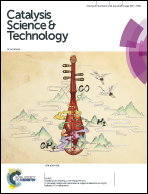Solvent effects on heterogeneous catalysis in the selective hydrogenation of cinnamaldehyde over a conventional Pd/C catalyst†
Abstract
Solvent effects in the selective hydrogenation of an α,β-unsaturated aldehyde of cinnamaldehyde (CAL) were investigated under gas–liquid–solid reaction conditions. A conventional 5 wt% Pd/C catalyst and twelve organic solvents were used, including apolar solvents (three) and protic (two) and aprotic (seven) polar ones. The total rate of CAL hydrogenation strongly depended on the solvents used. The relationship between the rate of CAL hydrogenation observed and a few different solvent parameters was examined. The main product was hydrocinnamaldehyde (HCAL) with a selectivity of 80% or higher in most of the solvents examined except for pyridine and 4-methylpyridine. In these two solvents, the CAL hydrogenation was slow and the main product was changed to cinnamyl alcohol (COL) with a selectivity of about 60%. The addition of a small volume of pyridine to other solvents such as 2-propanol and tetrahydrofuran could change the rate of hydrogenation and switch the main product from HCAL to COL. Possible interactions among the solvents, CAL substrate, and Pd/C catalyst were examined by FTIR (attenuated total reflection (ATR-) and diffuse reflectance modes (DR-)) and TPD to discuss the solvent effects observed in the Pd-catalyzed heterogeneous CAL hydrogenation.



 Please wait while we load your content...
Please wait while we load your content...